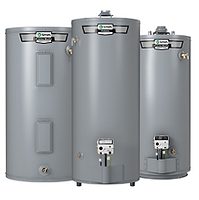Maryland country club saves cost, space with new installation

One of the emerging trends in the water heating industry is the growing demand for products that are easier and more cost-efficient to install. The trend is being driven by time-pressured contractors, ever-more-challenging installation environments and rapidly evolving product technology; especially in the high-efficiency commercial segment of the business.
A. O. Smith is addressing these issues in a number of ways, but one of the most innovative is the new common venting system now available for its Cyclone MXi family of condensing water heaters. The common venting system is an industry exclusive. It reduces the number of wall penetrations contractors must cut for intake air and exhaust, reduces the amount of vent piping needed for each installation, and saves precious floor space in mechanical rooms. Installers can manifold two units for an installation, but need to run just one intake and one exhaust for sidewall venting.
“This is the industry’s first non-powered, common venting system for a tank-type water heater,” said Matt Schulz, senior manager-commercial new product development at A. O. Smith. “The system uses either six-inch PVC or polypropylene venting pipe.”
The Hillendale Country Club, in Phoenix, Maryland, features a pair of Cyclone BTH-250s. For the last five months, the two high-efficiency water heaters have provided hot water to the club’s kitchen. Jeff Yates, a board member of the 500-member club, has spent more than two decades in the plumbing industry and recommended the Cyclone MXi water heaters.
Hillendale Country Club was originally established in 1923, making it one of Maryland’s oldest private golf clubs. The member-owned club has produced two Professional Golf Association (PGA) presidents, and has hosted innumerable tournaments. Hillendale moved to its present location in the 1950s.
“The current club house was built in 1995 and, at the time, we installed three atmospheric water heaters and a storage tank,” Yates explained.
As is often the case, the mechanical room at Hillendale is very small with “not a lot of head room,” according to Yates. When it came time to replace the aging atmospheric water heaters, the board wanted to upgrade to a higher-efficiency product that would help lower the club’s operating costs. The two units take up about half the floor space of their predecessors, a major benefit given the mechanical room’s small footprint.
The seven-foot ceilings do not provide a lot of space for venting, so the installer, James A. Quick of nearby Forest Hill, Maryland, was creative with the venting. Quick used two 45-degree elbows and approximately 30 feet of vent pipe. The common vent kit is rated for up to 50 equivalent feet of venting from the final “T” of an installation.
During peak demand periods, Hillendale frequently serves parties of between 500 and 600 guests, Yates explained, including plenty of weddings. This creates the need for a lot of hot water in the kitchen, a task for the Cyclone units. Conversely, during golf’s off-season, when business at the club slows down, the modulating feature allows the units to operate at up to 98 percent efficiency.
A common venting system was one of the new features envisioned when A. O. Smith introduced the Cyclone MXi modulating units in 2014, Schulz noted. The combustion system is designed to handle the flow rates and pressures associated with manifolded units.
“Because of the MXi’s modulating design, the blower helps maintain the pressure through the venting,” Schulz said.
Each of the common venting kits also includes a backflow preventer. The Cyclone MXi does not require any modification for the common venting kit. The engineering team worked with a supplier to develop an adapter for common venting.
Bob Borgeson, an engineer at A. O. Smith’s commercial product engineering center, explained, “The team has completed the certification work for the common vent kits for the larger BTH products and is now focused on the BTH-120 units.”
Next, A.O. Smith will develop and certify a common vent kit for three (or possibly more) Cyclone units.




